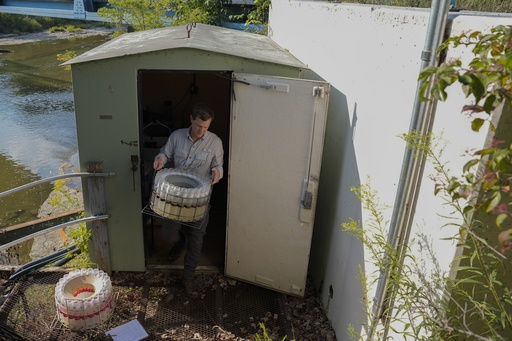
OREGON, Ohio — On a warm summer evening, a small boat cruised across the vibrant green waters of Lake Erie, passing by a beach where a child was playing and a newlywed couple posed for photos. Signs adorned in bright red warned beachgoers about hazardous algae toxins lurking in the water, often unnoticed or ignored.
About 70 miles away, farmer Bill Kellogg is actively addressing the persistent algae blooms plaguing the southernmost Great Lake in the United States. Rather than applying fertilizer on the surface of his fields as he once did, Kellogg has adopted a strip till machine that embeds fertilizer pellets 8 inches deep into the soil, preventing heavy rainfall from washing them away.
Kellogg is also cultivating cover crops that enhance the soil’s ability to trap nutrients and has established buffer strips of grasses and other plants in certain fields to absorb nutrient runoff before it enters local streams flowing into Lake Erie, where such runoff can exacerbate the algae situation.
“We recognize that the agricultural community is under scrutiny,” Kellogg noted.
The bacteria commonly identified as blue-green algae are found in bodies of water worldwide, however, when excessively fed with phosphorus and nitrogen from farm fertilizers, they can lead to harmful algae blooms detrimental to drinking water, marine life, recreation, and human health.
Western Lake Erie presents an ideal environment for these bacteria to flourish due to its relatively shallow depth of about 30 feet, allowing it to warm quickly during the summer. Nutrient runoff from farms across the basin eventually drains into the Maumee River, which empties into Lake Erie near Toledo.
Agricultural runoff, primarily from fertilizers, contributes approximately 80% of the nutrients entering Lake Erie, with half of that coming from the Maumee River alone.
Reducing phosphorus levels in the lake was a significant aspect of a 2015 agreement between the United States and Canada. The goal is to decrease phosphorus input into the lake by 40% by 2025. Current research indicates that phosphorus levels have dropped by about 32%, but there is skepticism about achieving the targeted reduction.
This year, the algae bloom in western Lake Erie was moderate when compared to previous years. It was first detected on June 24, marking the earliest appearance since monitoring began, and peaked in late summer, covering approximately 660 square miles—larger than in some past years, though not as concentrated as previous blooms.
With climate change, it is anticipated that the onset of algae blooms will occur earlier, last longer, and become more toxic due to increased rainfall and warming temperatures.
“If conditions persist and climate changes unfold as expected, the situation will likely deteriorate,” said Nate Manning, interim director of the National Center for Water Quality Research.
For Kellogg, who cultivates 7,400 acres of corn and soybeans, conservation practices have always held personal significance. His family’s frequent visits to Lake Erie for fishing and swimming only intensified his commitment following a severe algae bloom in 2014 that temporarily halted drinking water for over 400,000 residents in Toledo and southern Michigan.
“That incident propelled us into action,” Kellogg remarked.
Kellogg invested over $1 million in the strip till machine and associated equipment, allowing him to bury solid fertilizer several inches underground. Although it was a significant initial cost, he now saves around $300,000 annually on fertilizer due to reduced runoff. Any liquid fertilizer used is stored in tanks housed in a concrete contour designed to manage leaks effectively.
“Our crop yields have increased, and fertilizer expenses have decreased. Once we prove a method effective and beneficial, we no longer need external motivation to continue,” Kellogg added.
In the Sandusky Bay area along Lake Erie’s southwestern shore, the Ohio Department of Natural Resources, in collaboration with various conservation organizations, is working to restore wetlands that effectively filter nutrient runoff before it reaches the bay. Restoration efforts include reconnecting water channels through former agricultural areas and constructing island barriers along the coast as part of these initiatives.
As part of the H2Ohio initiative launched in 2019, the Ohio Department of Natural Resources and partnering organizations have completed 23 wetland restoration projects within the western Lake Erie Basin, with another 49 currently in progress. While these actions contribute to water quality improvement, Mary Mertz, director of the Ohio Department of Natural Resources, cautioned that additional strategies are necessary.
“You cannot solely rely on wetland restoration to resolve Lake Erie’s issues; a multifaceted approach is essential,” she emphasized.
Researchers from the National Center for Water Quality Research in Tiffin continuously monitor phosphorus levels in the lake. Their findings indicate a downward trend, but consistent adherence to the 40% reduction target remains a challenge.
“There’s a lot of positive progress,” Manning stated.
However, increased funding and broader adoption of conservation and nutrient management practices by farmers remain crucial, according to Emily Kelly from the Ohio Environmental Council. A recent study revealed that Ohio needs to contribute between $170 million and $250 million in funding to achieve its nutrient reduction objectives, with Michigan requiring an additional $40 million to $65 million.
In Ohio, farmers have enrolled about 1.5 million acres into nutrient management plans within the western Lake Erie basin, representing around 43% of the area’s cropland. The goal is to expand that to at least 50%, according to the Ohio Department of Agriculture.
Farmers are encouraged to develop their individualized plans and may earn up to $40 per acre in incentive payments. These plans are tailored to incorporate practices like cover cropping and strategic fertilizer application that best suit their fields.
For real change, many farmers may need to invest in multiple methods, adding to costs and potential discouragement, noted Jordan Hoewischer from the Ohio Farm Bureau.
Kellogg believes that if more farmers voluntarily embrace these conservation approaches, it reduces the likelihood of governmental regulations coming into play. He prefers farmers to take initiative on their own.
“We may have been part of the problem initially, but it is our responsibility to contribute to the solution,” he concluded.
